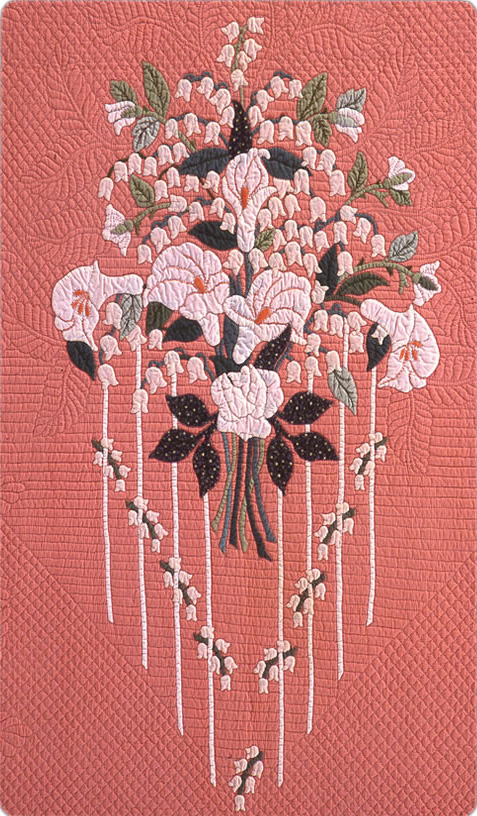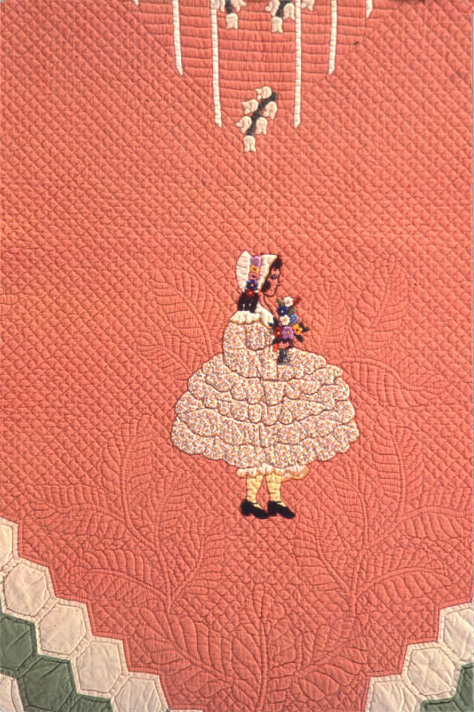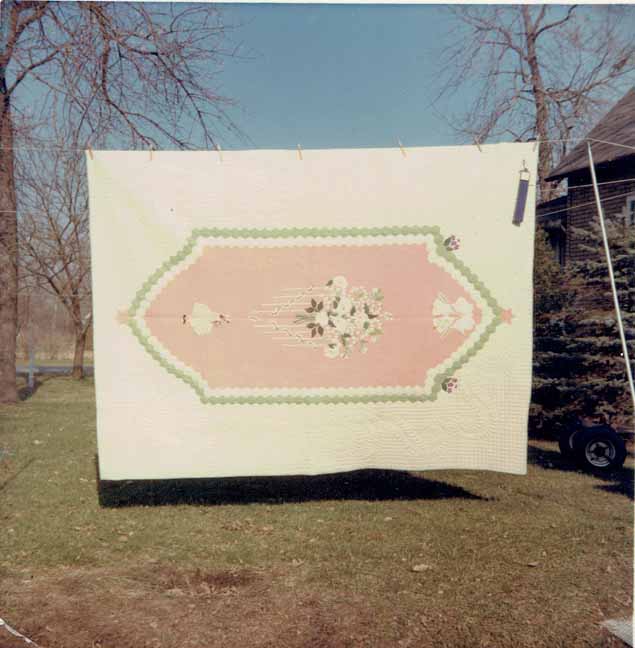BACK TO QUILTS
Bridal Bouquet; Bridal Bouquet (Doris and Elmer Gasperik); Wedding Quilt
CITE THIS QUILT

QUILT INDEX RECORD
18-14-46
Description:
In this 1944 wedding quilt Gasperik tapped multiple sources to create an original design. She transposed a Detroit News Lily quiltING pattern into an appliqué lily at the bouquet's center. Other appliquéd floral designs in the bouquet may have come from Nancy Cabot/Chicago Tribune. The appliquéd flower girl is likely Gasperik's assemblage of ideas from multiple sources. For example, Gasperik might have taken her idea to embroider sausage curls under the girl's bonnet from a W.L.M. Clark (Grandmother Clark) set of quilt block patterns called Poster Girls advertised in Herrschner catalogs 1935-1937. The ferns and feathers quilted in abundance on this and other quilts came from an Aunt Martha quilting booklet.
Essay:
Of all the Gasperik quilts, this 1944 ‘Bridal Bouquet’ bears the greatest profusion of one of Gasperik’s favorite quiltING patterns – the fern leaf. Gasperik quilted these ferns onto at least 16 different quilts. Her pattern source was ‘Aunt Martha’ , which marketed the pattern (#C5573) based on its extensive use in the grand-prize-winning quilt of the Sears Contest of 1933, the famous “Star of the Bluegrass” submitted by Margaret Caden of Kentucky. It was probably seeing the Sears Contest quilts on display at the Century of Progress Chicago World’s Fair of 1933-34 that introduced Gasperik to quiltmaking and launched what became her life’s work. That particular pattern seems to have held particular significance, explaining why she used it so often and so creatively. In that same Aunt Martha booklet is pattern C5580, a large and elaborate sculptured feather motif which Gasperik quilted onto a second bridal quilt made for a special family member, Karen’s ‘Bridal Bouquet’ quilt #064, made in 1956. This same motif is the major quiltING focus of a third Gasperik quilt, the elegant ‘Leaf and Vine (Burgundy) #024, an undated quilt. In her quiltING, Gasperik selected and repeated particular motifs with great care, creating a body of work which was identifiably hers.
Where are the records for this quilt housed?
Mary Gasperik Legacy Project
Who documented this quilt?
Mary Gasperik Private Collection
Gasperik Legacy Project Number:
012
This is a:
Finished quilt
Quilt's title:
Bridal Bouquet
Owner's name for quilt:
Bridal Bouquet (Doris and Elmer Gasperik)
Names for quilt's pattern in common use:
Wedding Quilt
How wide is the quilt?
73 inches
How long is the quilt?
96 inches
Shape of edge:
Straight
Shape of corners:
Straight
What color is the quilt?
Coral; Green; White
Quilt's condition:
Excellent/like new
Type of inscription:
Date
What is inscribed on the quilt?
1944
What is the date inscribed on the quilt?
1944
Method used to make the inscription:
In the quilting
Location of inscription:
other
Describe where the inscription was found:
1944 is quilted into the four white center hexagons above the wedding bells at the top of the quilt.
Time period:
1930-1949
When was the quilt finished?
1944
Family/owner's date for quilt:
1944
Who estimated the quilt's date?
Merikay Waldvogel
Further information concerning dates:
Quilt made as a wedding gift for Elmer and Doris Gasperik in 1944.
Describe the quilt's layout:
Medallion or framed center
Subject of the quilt:
Wedding
Describe the quilt setting:
Elongated center panel is bordered with a row of white hexagons and a row of green hexagons.
What is the shape of the quilt blocks?
Hexagons
Fiber types used to make the quilt top:
Cotton
Fabric styles used in the quilt top:
Print; Solid/plain
Piecing techniques used to make the quilt top:
Hand Piecing
Applique techniques used to make the quilt top:
Hand Applique
Embellishment techniques used to make the quilt top:
Embroidery
Describe embellishment materials or techniques:
note the embroidered curls of the flower girl
Materials used to make the back:
Cotton
Describe the back:
Solid/plain
Materials used in the quilt binding:
Cotton
How is the binding made?
Bias grain
What is the width of the binding (measure on the top only)?
less than a half inch
What kind of filling is used in the quilt?
Cotton
How are the layers held together?
Hand quilting
Color of thread used in the quilting:
white
Can you see any knots on the front or back of the quilt?
no
Quilting designs used, overall motifs:
Grid/crosshatch; Grid diamond; In-the-ditch; Patches outlined/in the ditch
Quilting designs used, decorative motifs:
Feathering; Floral; Other
Quilting designs used, background fills:
Grid/crosshatch; Other
Describe the quilting designs used:
Fern quiltING design lines the inner edge of the coral panel; broad sweeping feather plumes fill the outer white areas.
Features or notes about the quilt's appearance, materials, or construction:
This special quilt with elaborate quilting and minute applique depicted in the wedding bouquet, as well as in the flower girl, is an example of the exceptional needlework skills Gasperik developed.
Quilt top made by:
Gasperik, Mary
Quilted by:
Gasperik, Mary
Where the quilt was made, city:
Chicago
Where the quilt was made, county:
Cook County
Where the quilt was made, state:
Illinois (IL)
Where the quilt was made, country:
United States
How was this quilt acquired?
Inheritance
Why was the quilt made?
Gift or presentation
The quilt was made to be used for:
Artwork/wall hanging
Quilt is presently used as:
Keepsake/memento
Describe present uses of the quilt:
Mary's grandchildren regard her quilts as a unique collection to be preserved and appreciated.
Where did the maker get their materials?
Purchased new
Where did the maker find their pattern?
Original to maker
Describe the source of the pattern:
Gasperik used the Detroit News Applique Lily Design (Leaflet #1743-ID48). And Nancy Cabot #32.8 and #32.83 (Chicago Tribune) patterns may be the design source for the Lilies of the Valley.
Where did the quiltmaker find the pattern for the quilting design on the quilt?
Published material
What is the commercial name of the quilting design used for this quilt?
Fern quilting motif is #C5573 and large feather motif is #C5580 - "Aunt Martha's Answer To 'How Shall I Quilt It?'"
Describe anything about the design of the quilt that wasn't already recorded in a previous field:
Unusual for a Gasperik quilt, this one lacks even one border, but its broad expanse of of white ground filled with large feather motifs, edged with a narrow pale green binding, creates an equivalent frame for the medallion bouquet.
The style of this wedding bouquet, with its long drooping ribbons and bending stalks of lily of the valley mixed in with larger flowers, is reminiscent of traditional Hungarian bridal costume (in which ribbons droop down from the bride's headdress, past her face). Gasperik’s embroidered appliqué bouquet also resembles traditional Hungarian floral embroidery – both the plump flowers and the flat traditional white cutwork embroideries known as Madeira Work and Richelieu Work (also called riselin) for which needlework from Kalocsa is especially famous.
Gasperik might easily have adapted the Nancy Cabot pattern called Violet Block to create the two clusters of appliqué pansies appearing in the upper right and left corners of the medallion of this quilt. The pattern appeared in The Chicago Tribune 8-9-1935 (p 169-NC, Index to the Nancy Cabot Quilt Blocks M-Z compiled by Rose Lea Alboum, American Legacy Quilt Index, copyright 2005 by Rose Lea Alboum]. Gasperik frequently used Cabot patterns and many Cabot clippings from her hometown newspaper are pasted into Gasperik’s quilt album [private collection, Karen Finn].
Exhibitions where this quilt was displayed:
Illinois State Fair, 1946
Illinois State Fair , 1953
The Quilts of Mary Gasperik, Ravenswood Historic Site, Livermore, CA, March 14-15, 1992.
This is one of the 23 Mary Gasperik quilts exhibited in the Carnegie Room of the Marion Indiana Public Library July 16-17, 2021 in connection with the ceremony honoring the induction of Mary Gasperik into The Quilters Hall of Fame as their 2021 Legacy Quilter honoree. Mary Gasperik Quilters Hall of Fame Induction Exhibit.
Contests entered:
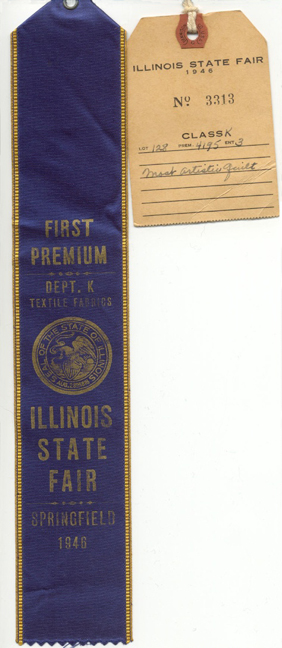
Illinois State Fair 1946, blue ribbon for "Most Artistic"
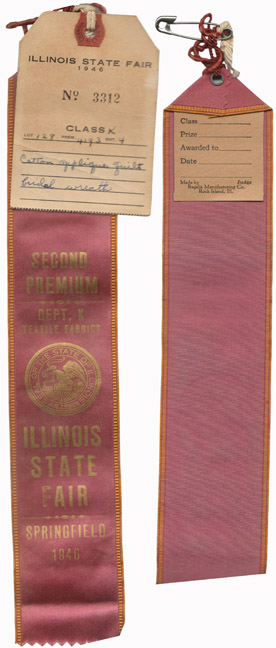
Illinois State Fair 1946, pink ribbon, for "Cotton Applique Quilt"
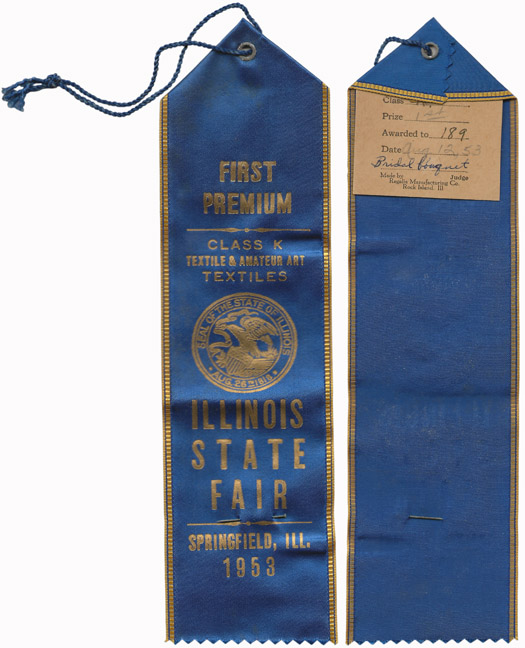
Illinois State Fair 1953, blue ribbon
Publications (including web sites) where this quilt or maker was featured:
Merikay Waldvogel and Barbara Brackman. Patchwork Souvenirs of the 1933 Chicago World's Fair, (Nashville, TN: Rutledge Hill Press, 1993)102-103.
Merikay Waldvogel "One American Dream Comes True", Quilters Newsletter Magazine, March 2008, 46-49.
Related items such as diaries, obituaries, wills, household inventories, or pictures of the quiltmaker:
Letter from Miss Veronica Gavin to Mary Gasperik, dated Aug 17, 1946 reading "In my visit of [sic] the sewing building at State Fair yesterday I couldn't forget the two beautiful quilts which belonged to you. I especially like the "daisies won't tell" pattern and also the wedding design, so if it wouldn't be too much trouble & asking too much of you I would appreciate having both the wedding pattern and the daisy one."
1946 Illinois State Fair Blue ribbon in private collection of Elmer Gasperik heirs with attached cardboard tag reading "Illinois State Fair 1946 No. 3313, Class K, Lot 128, Prem. 4195 Ent 3 Most artistic quilt". It is likely that this ribbon was attached to this quilt.
The East Hazelcrest News issue No. 18, dated Sept. 23,1953, published by American Legion Post 1139 mentions that "one of the women of our village, Mrs. Stephen Gasperik, was awarded 2 first prizes & a second prize at the Ill/ State Fair for her quilts. The 2 first were given for her 'Delectable Mountain' quilt & 'Bridal Bouquet'. The second place ribbon was placed on her 'Indiana Wreath'. Last year she won a 1st & two 3rds. Quilting is almost a lost art, requiring a tremendous amount of patience & skill with a needle." Elmer Gasperik heirs, private collection.
Kalocsa kincse/Treasures of Kalocsa, Kati Fejer, 2006, Budapest, Hungary (collection of Susan Salser) presents excellent photographs, text and some instructional traditional needlework patterns. "We know that ladies in Transylvania and the Matyo region of Hungary also embroider Kalocsa designs..." (p 124). Gasperik was from Transylvania.
Ownership of this quilt is:
Private
Quilt owner's name:
Elmer Gasperik heirs - Kathy Jacob contact
Quilt owner's country:
United States
Person filling out this form is:
Relative of quiltmaker; Author/researcher
If you are a relative of the quiltmaker, how are you related? The quiltmaker is my:
Grandmother
Describe the relationship to the quilt's maker:
Grand-daughter Susan Salser began this research effort in 1991, after she and her two sisters divided up the quilts which belonged to their mother (Elsie Gasperik Krueger) who died in 1988. Her ongoing research has been fruitful and interesting.
Quiltmaker's maiden name:
Mihalovits, Maria
Quiltmaker's gender:
Female
Quiltmaker's birth date:
01/25/1888
Quiltmaker's birthplace, country:
Hungary
Quiltmaker's marriage date(s):
11/18/1906
Quiltmaker's date of death:
05/25/1969
Quiltmaker's ethnic background/tribal affiliation:
Hungarian
Quiltmaker's educational background:
Elementary School
In which kind of environment did the quiltmaker live?
Rural
Quiltmaker's city:
Chicago
Quiltmaker's county:
Cook
Quiltmaker's state:
Illinois (IL)
Quiltmaker's country:
United States
Quiltmaker's father's name:
Mihalovits, Istvan
Quiltmaker's father's birthplace:
Hungary
Quiltmaker's father's ethnic/tribal background:
Hungarian
Quiltmaker's mother's name:
Mihalovits, Vidoszava
Quiltmaker's mother's birthplace:
Hungary
Quiltmaker's mother's ethnic/tribal background:
Hungarian
Quiltmaker's spouse's/spouses' and /or partner's/partners' name(s):
Gasperik, Stephen
Quiltmaker's spouse's/spouses' and/or partner's/partners' ethnic/tribal background:
Hungarian
Quiltmaker's spouse's/spouses' and/or partner's/partners' occupation:
Milk Dealer/Grocery Store Owner/Butcher
Number of children:
3
How many of the quiltmaker's children were girls?
1 (Elsie 1909-1988)
How many of the quiltmaker's children were boys?
2 (Elmer and Stephen)
How did the quiltmaker learn to quilt?
From guild or club member; Self-Taught
When did the quiltmaker learn to quilt?
Age 40-49
Why does the quiltmaker quilt?
Pleasure; Other
Other notes on how the quiltmaker learned, and how and why they quilt:
To exhibit in shows held by her Tuley Park quilt club in Chicago, the Detroit News quilt show in Detroit, many Illinois State Fairs, at least one Indiana State Fair. She entered quilts in at least 2 Chicago department store contests. She made at least one quilt and one quilt top specifically for the 1939 New York Worlds Fair quilt contest. She also made children's quilts specifically for grandchildren and great-grandchildren; and wedding and wedding anniversary quilts for her son Elmer and grand-daughter Karen. Primarily, she wanted to make quilts because it was her life passion and her greatest talent. The occasions and venues to show them presented themselves. It should be noted that prior to Mary's emigration to America in late 1904, at age 16, she was an apprenticed needleworker in her native Hungary. The intricate and colorful floral embroideries traditional to Hungary lend themselves especially well to applique, the quilt style Mary preferred.
Does/did the quiltmaker belong to a group? Name of the group?
Tuley Park Quilt Club and Detroit News Quilt Club
Does/did the quiltmaker belong to a group?
Southside Chicago and Detroit MI
What are the main activities of the group?
Chicago group met to quilt and held periodic quilt shows; Detroit group held national exhibits and contests.
Estimated number of quilts made by this quiltmaker:
more than 50
Does/did the quiltmaker sell quilts?
no
Does/did the quiltmaker teach quilting?
no
Who photographed this quilt?
Don Gonzalez
Access and copyright information:
Restricted
Copyright holder:
Hank Finn
Details
Cite this Quilt
Gasperik, Mar. Bridal Bouquet. 1944. From Mary Gasperik Legacy Project, Mary Gasperik Private Collection. Published in The Quilt Index, https://quiltindex.org/view/?type=fullrec&kid=18-14-46. Accessed: 04/26/24
-
Gallery
Gasperik 06: Gifts for Weddings & ...
Waldvogel, Merikay
-
Ephemera
Lily Bouquet Quilting Pattern
The Detroit News
-
Essay
Mary Gasperik (1888-1969): Her Lif...
Waldvogel, Merikay
-
Exhibit
The Quilts of Mary Gasperik
Salser, Susan
-
Ephemera
The Quilts of Mary Gasperik
Salser, Susan
-
Essay
Mary Gasperik and The Illinois State F...
Salser, Susan
-
Ephemera
Dear Mrs. Gasperik:
Gavin, Veronica
-
Ephemera
Mrs. Gasperik Wins Prizes
Chicago area newspaper
-
Exhibit
Mary Gasperik Quilters Hall of Fame In...
Salser, Susan
-
Gasperik, Mary Quiltmaker
Mary Gasperik Legacy Project
